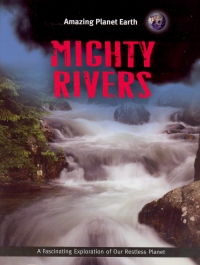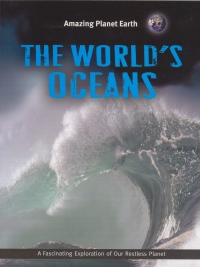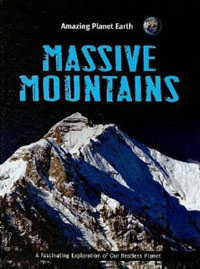| ________________
CM . . .
. Volume XVI Number 35. . . .May 14, 2010 
 |
Mighty Rivers. (Amazing Planet Earth).
Jen Green.
Collingwood, ON: Saunders Book Co., 2010.
32 pp., pbk. & hc., $10.95 (pbk.), $23.95 (hc.).
ISBN 978-1-897563-79-3 (pbk.), ISBN 978-1-59920-371-3 (hc.).
Subject Heading:
Rivers-Juvenile literature.
Grades 3-8 / Ages 8-13.
Review by Sherry Faller.
*** /4
|
| |
|
 |
The World's Oceans. (Amazing Planet Earth).
Jen Green.
Collingwood, ON: Saunders Book Co., 2010.
32 pp., pbk. & hc., $10.95 (pbk.), $23.95 (hc.).
ISBN 978-1-897563-81-6 (pbk.), ISBN 978-1-59920-373-7 (hc.).
Subject Heading:
Ocean-Juvenile literature.
Grades 3-8 / Ages 8-13.
Review by Sherry Faller.
*** /4
|
| |
|
 |
Massive Mountains. (Amazing Planet Earth).
Terry Jennings.
Collingwood, ON: Saunders Book Co., 2010.
32 pp., pbk. & hc., $10.95 (pbk.), $23.95 (hc.).
ISBN 978-1-897563-78-6 (pbk.), ISBN 978-1-59920-370-6 (hc.).
Subject Heading:
Mountains-Juvenile literature.
Grades 3-8 / Ages 8-13.
Review by Sherry Faller.
*** /4
|
| |
|

excerpt:
News Flash – March 15, 2005
The snowcapped summit of Mount Kilimanjaro has melted away to reveal the tip of the African peak for the first time in 11,000 years. The glaciers and snow, which kept the summit white, have almost completely disappeared. Scientists had predicted the melt. However it is 15 years sooner than they had estimated. The white peak of the 19,340 foot (5,895m) mountain has long formed a stunning part of Tanzanian landscape. (From Massive Mountains.)
The "Amazing Planet Earth" series has six titles. The three included in this review are Mighty Rivers, Massive Mountains, and The World's Oceans. Other titles in this series are Violent Volcanoes, Earthquakes and Tsunamis and Extreme Weather. The series aims to excite students about the fascinating and sometimes ferocious features of our planet.
Many grade levels would find these books to be excellent references. Grades 3 and 8 could use Mighty Rivers and The World's Oceans to explore the Nile River and water systems, respectively. Grades 4 and 7 could use Mighty Mountains when studying erosion and the earth's crust. Weather phenomena for the Grade 5 unit on weather are featured in all three books.
All the books include the usual contents, index and glossary components which are so essential when doing research. In addition, there are four websites listed in each book which actually work and are very kid-friendly. Each listing has a short explanation to help the reader decide if the site is relevant. Some are better for middle years students, and some are interactive for elementary students. The contents includes a variety of 'Case Studies' and 'Science Reports' which whet the appetite to read more. The Case Studies provide information about a place in the world, shown on an inserted map that serves as an example of the feature being discussed. The double page spread also has a "Data File" box with bulleted short facts about the topic. These could be used to branch off into more diversified research and discussion. For example, a fact about the Nile River reads: "Ancient Egyptians used the Nile's floodwater to move the stones needed to build their pyramids." Students could then check other sources to find out just how that was done. The 'Newsflash' feature looks like a clipping from a newspaper and offers a tidbit of information of a real catastrophe and when and where it took place.
Wonderful coloured photos splash every page illustrating the river, mountain or weather occurrence. A few labeled diagrams explain the course of how something like a flash flood might happen. The writing style is easy to read for grades 4 to 8 but still packed full of information for younger and older students. The use of a variety of text boxes, news clips, captions and data files ensures that every reader will find it easy to gain information from the text. Much research went into the writing of these books.
Mighty Rivers offers an excellent array of information about all the parts of a river from the spring to the delta. The water cycle is explained, and the power of moving water is demonstrated with pictures of erosion in the Grand Canyon and Niagara Falls. Flash flooding in Mississippi and the Hurricane Katrina overflow that destroyed so much of New Orleans are good up-to-date examples of what water can do.
The World's Oceans looks at tectonic plates, volcanic ridges and seashore erosion. Tsunamis caused by earthquakes and storm surges caused by hurricanes are discussed. Even icebergs and melting polar icecaps are mentioned. Of special interest is man's ability to fight the forces of nature and water by reclaiming land in places like the Netherlands.
Massive Mountains will make the reader want to climb some of the world's mountains. Starting with the highest range, the Himalayas and Mt. Everest, man's effect on these majestic structures proves to be humbling. Garbage left on the mountains? How can we prevent this from continuing? Different types of mountains, such as folded, dome and volcanic, are diagramed. The influences of weather and man, including rock fall, slumping, avalanches and mudslide, are moving.
The books in this series are very good for research and a welcomed resource for school libraries both in elementary and middle years.
Recommended.
Sherry Faller is a teacher-librarian in Winnipeg, MB.

To comment
on this title or this review, send mail to cm@umanitoba.ca.
Copyright © the Manitoba Library Association. Reproduction for personal
use is permitted only if this copyright notice is maintained. Any
other reproduction is prohibited without permission.
NEXT REVIEW |
TABLE OF CONTENTS FOR THIS ISSUE
- May 14, 2010.
AUTHORS |
TITLES |
MEDIA REVIEWS |
PROFILES |
BACK ISSUES |
SEARCH |
CMARCHIVE |
HOME |


